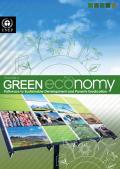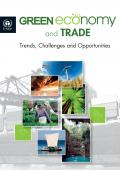New business models can make an important contribution to the transition to green growth. While some new business models involve large firms, others are small start-up firms that seek to exploit technological or commercial opportunities that have been neglected or not yet explored by more established firms. New firms tend to engage in more radical innovation than existing firms, and scaling up new business models can therefore help reduce environmental pollution, optimise the use of natural resources, increase productivity and energy efficiency, and provide a new source of economic growth. Although the market for green goods and services is growing, the development of new business models is affected by a range of barriers, many of which can be addressed by well-designed policies.
A green economy can be defined as one that results in improved human well-being and social equity, while significantly reducing environmental risks and ecological scarcities. It is characterised by substantially increased investments in economic sectors that build on and enhance the Earth’s natural capital or reduce ecological scarcities and environmental risks. These investments are driven or supported by national policy reforms and the development of international policy and market infrastructure.
Both fiscal policy and public finance can be key drivers of a country’s transition to a greener economy—or a brake on green growth and low carbon job creation. This paper explores the linkage and options available to policy-makers considering ways to drive and accelerate the transition to lowercarbon, more resource-efficient and socially-inclusive economic growth.

The Green Economy Report is compiled by UNEP’s Green Economy Initiative in collaboration with economists and experts worldwide. It demonstrates that the greening of economies is not generally a drag on growth but rather a new engine of growth; that it is a net generator of decent jobs, and that it is also a vital strategy for the elimination of persistent poverty. The report also seeks to motivate policy makers to create the enabling conditions for increased investments in a transition to a green economy.
The report includes chapters on the following areas:
- Agriculture
- Fisheries
- Water
- Forests
- Renewable Energy
- Manufacturing
- Waste
- Buildings
- Transport
- Tourism
- Cities
- Modelling
- Finance

This publication provides a summary for policy makers of the OECD’s Towards Green Growth publication. The publication summarises the development of the OECD’s Green Growth Strategy and covers issues such as what green growth is and why it is needed, sources of green growth, a framework for green growth strategies, green growth initiatives, how green growth will affect employment, addressing distributional concerns, international co-operation, monitoring progress towards green growth, constructing green growth strategies and the next steps of the OECD Green Growth Strategy.
Policies that promote green growth need to be founded on a good understanding of the determinants of green growth and of related trade-offs or synergies. They also need to be supported with appropriate information to monitor progress and gauge results.
Monitoring progress towards green growth requires indicators based on internationally comparable data. These need to be embedded in a conceptual framework and selected according to well specified criteria. Ultimately, they need to be capable of sending clear messages which speak to policy makers and the public at large.
This report responds to these needs and accompanies the OECD Green Growth Strategy. It presents a conceptual framework, a proposal for developing green growth indicators and results for selected indicators derived from OECD databases.
The indicators presented in this report are a starting point: they will be further elaborated as new data become available and concepts evolve. They are accompanied with a measurement agenda that will help addressing the most pressing data development needs.
Green jobs in Mauritius stands at around 6.3 per cent of total employment (35,160 jobs out of a total of 558,100). This policy brief provides a summary of the assessment of existing green jobs in Mauritius undertaken in 2010. It concludes with providing a short term projection of a green growth scenario as opposed to a conventional one. The assessment originated from a request by the Government of Mauritius and was conducted by the ILO and a research team in Mauritius in 2011/2012. Its aim is to inform the Ministry of Labour as a contribution to shaping the Maurice Ile Durable (MID) strategy launched in 2008, which intends to make Mauritius a model country of sustainable development.
This report addresses two of the defining challenges of the twenty-first century: achieving environmental sustainability and turning the vision of decent work for all into a reality. It shows that not only are both challenges urgent, but they are also intimately linked and will have to be addressed together. While it is certain that environmental degradation and climate change will increasingly require enterprises and labour markets to react and adjust, the goal of environmentally sustainable economies will not be attained without the active contribution of the world of work.
The European Commission and the International Labour Organization have combined efforts in reaction to the deep crisis that hit the global economy in 2008. The aim of this joint project is to examine policies that will lead not only to a quicker recovery but also to a more sustainable, environmentally friendly and equitable global economy. 'Towards a Greener Economy: The Social Dimensions' aims to promote a clearer understanding of the nature of the green economy and its implications for labour markets, especially the reallocation of jobs from high- to low-polluting sectors.
This report - which contains case studies of Melbourne, Vancouver, Paris, Toyama and Portland - offers a comprehensive understanding of the compact city concept, its role in today’s urban contexts, and the potential outcomes of compact city policies. It examines compact city policies across the OECD in relation to green growth objectives and the role of indicators in tracking policy performance. The report proposes compact city strategies and ideas for achieving better outcomes and highlights governance challenges for implementing practical compact city strategies. Importantly, it highlights how urban spatial policies can help foster economic growth and development while preventing environmental degradation and climate change. The report thus addresses a central concern of the OECD Green Growth Strategy, and provides an important contribution to it.
